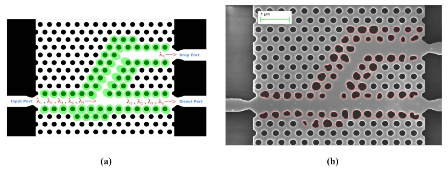The topology optimization method has recently been successfully applied to a range of photonic crystal (PhC) based structures and devices. This method was originally developed for mechanical problems, but has more recently been applied to PhC design. In the NATEC project, the topology optimization method is used to design PhC devices, which has specific properties such as dispersion. The main challenge is to make the designs robust to variations, such as under- or over-etching, in the manufacturing process.

Initial design of a photonic crystal waveguide drop filter defined by air holes (black) arranged in a triangular lattice in silicon (white). (b) SEM image of the optimized and fabricated single-channel drop filter obtained by utilizing 3D topology optimization.
We work on the following topics:
- Topology optimization of (2D) slow light waveguides, for applications such as Photonic crystal frequency splitters and mode conversion in a photonic crystal waveguide
- Development of Finite-Difference Time-Domain (FDTD) based 3D modeling and topology optimization framework for nano-photonic analysis and design.
- Development of methods for providing designs robust to manufacturing variations.
Relevant NATEC papers:
F. Wang, B. S. Lazarov, and O. Sigmund, “On projection methods, convergence and robust formulations in topology optimization”, Struct. Multidiscip. Optim. 43, 767–784 (2010).
R. Matzen, J. S. Jensen, and O. Sigmund, “Topology optimization for transient response of photonic crystal structures”, J. Opt. Soc. Am. B 27, 2040 (2010).
F. Wang, J. S. Jensen, and O. Sigmund, Robust topology optimization of photonic crystal waveguides with tailored dispersion properties, 2011.
M. Schevenels, B. Lazarov, and O. Sigmund, “Robust topology optimization accounting for spatially varying manufacturing errors”, Comput. Methods Appl. Mech. Eng. 200, 3613–3627 (2011).
R. Matzen, J. S. Jensen, and O. Sigmund, “Systematic design of slow-light photonic waveguides”, J. Opt. Soc. Am. B 28, 2374 (2011).
Y. Elesin, B. Lazarov, J. Jensen, and O. Sigmund, “Design of robust and efficient photonic switches using topology optimization”, Photonics Nanostructures - Fundam. Appl. 10, 153–165 (2012).
F. Wang, J. S. Jensen, and O. Sigmund, “High-performance slow light photonic crystal waveguides with topology optimized or circular-hole based material layouts”, Photonics Nanostructures - Fundam. Appl. 10, 378–388 (2012).
F. Wang, J. S. Jensen, J. Mørk, and O. Sigmund, “Systematic design of loss-engineered slow-light waveguides.”, J. Opt. Soc. Am. A. Opt. Image Sci. Vis. 29, 2657–66 (2012).
M. Jansen, B. S. Lazarov, M. Schevenels, and O. Sigmund, “On the similarities between micro/nano lithography and topology optimization projection methods”, Struct. Multidiscip. Optim. 48, 717–730 (2013).
Y. Elesin, B. Lazarov, J. Jensen, and O. Sigmund, “Time domain topology optimization of 3D nanophotonic devices”, Photonics Nanostructures -Fundam. Appl. 12, 23–33 (2014).
L. H. Frandsen, Y. Elesin, L. F. Frellsen, M. Mitrovic, Y. Ding, O. Sigmund, and K. Yvind, “Topology optimized mode conversion in a photonic crystal waveguide fabricated in silicon-on-insulator material.”, Opt. Express 22, 8525–32 (2014).
M. Zhou, B. S. Lazarov, and O. Sigmund, “Topology optimization for optical projection lithography with manufacturing uncertainties.”, EN, Appl. Opt. 53, 2720–9 (2014).